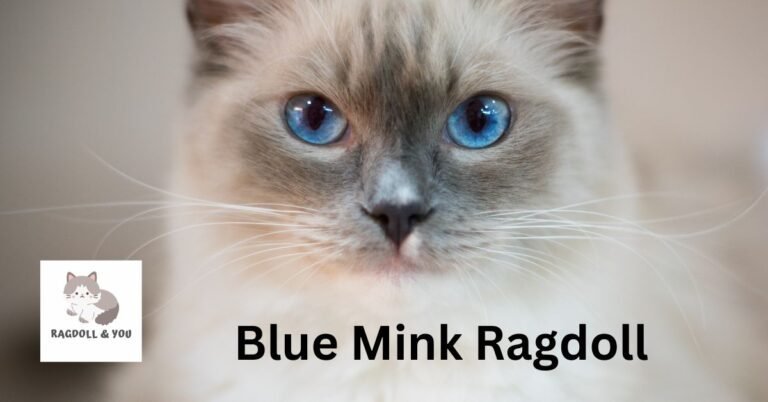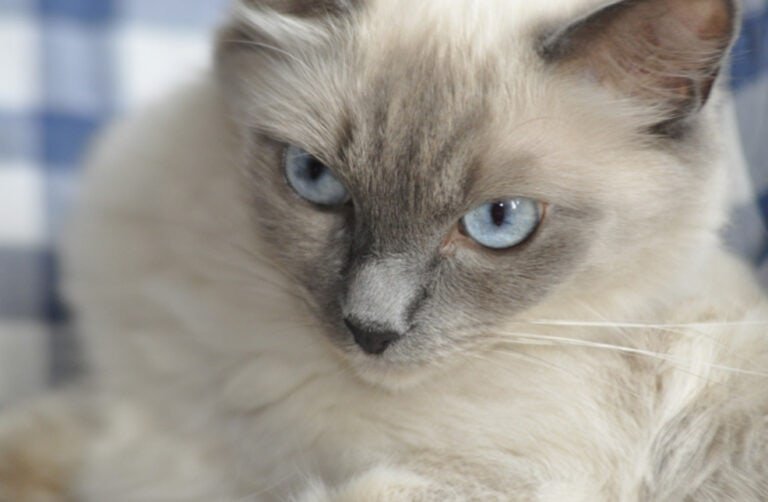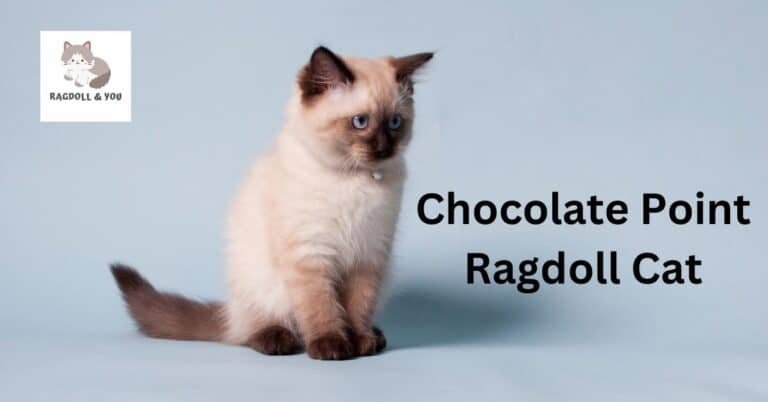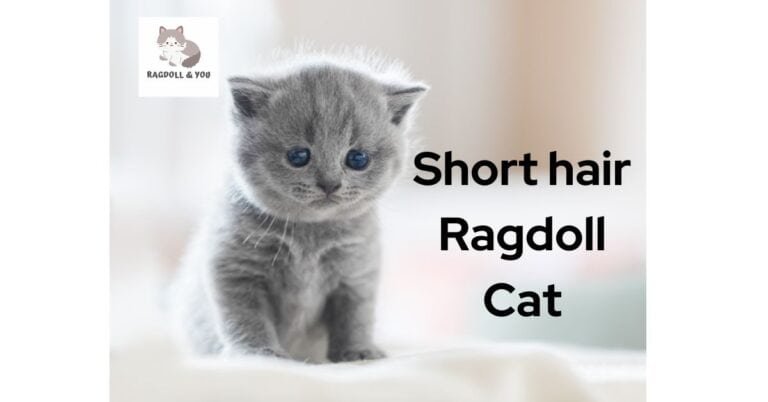Lynx Ragdoll Cats Guide: Colors And Patterns
The Lynx Ragdoll cat is truly stunning with its wildcat stripes and bright blue eyes. But behind its exotic looks is a true sweetheart personality – relaxed, affectionate, and always seeking human laps to lounge on.
In this article, we’ll explore the genetics behind the Lynx Ragdoll’s fascination coat patterns. We’ll also reveal why these cats make such wonderful companions for cat lovers around the world.
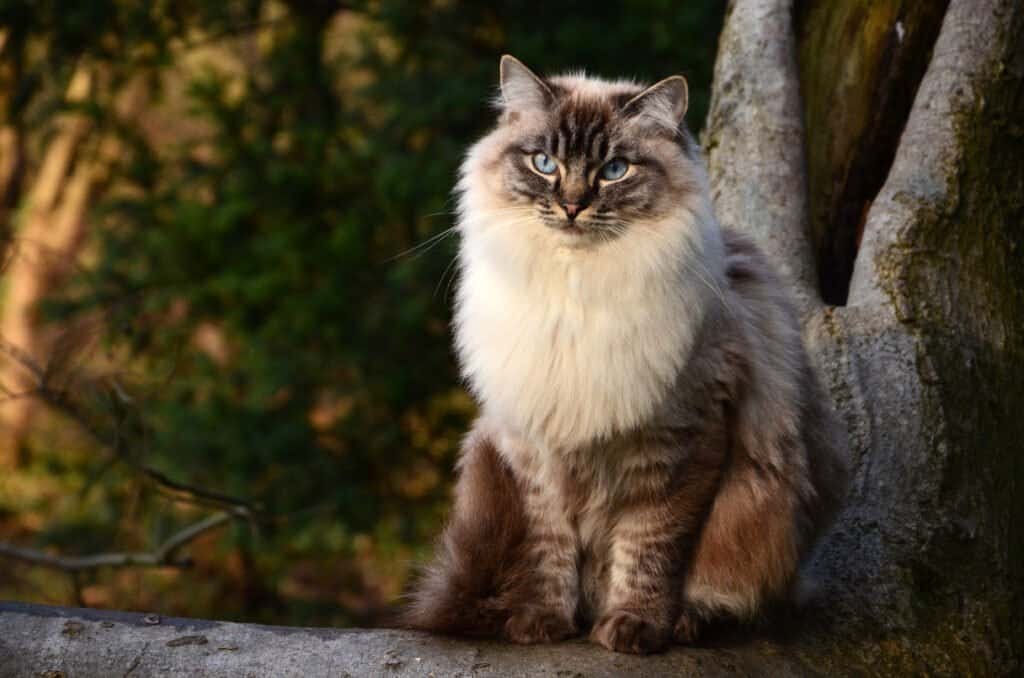
How has the blue lynx ragdoll gained popularity?
The blue lynx Ragdoll has gained significant popularity over the decades since the origins of the Ragdoll breed in the 1960s. This classic pointed pattern first emerged when Ragdoll founder Ann Baker began her selective breeding program in California.
The blue lynx was one of the four original Ragdoll patterns that Baker established, alongside bicolor, mitted and solid.
In the early years, the blue lynx attracted attention for its striking contrast between the pale creamy body and the deep blue-gray points on the extremities. The variety drew admirers at cat shows in the 1970s as the Ragdoll breed gained its initial following.
As photos of the Ragdolls spread through books and magazines in the 80s and 90s, the distinctive look of the blue lynx Ragdoll gained wider exposure.
Everything You Need To Know About Lynx Ragdolls
Lynx Ragdoll cats are a unique breed with fascinating origins and captivating physical traits. Cat enthusiasts find them enthralling for more reasons than one.
Origin and History
Lynx Ragdoll cats originated in the 1960s. They come from Riverside, California. The Lynx pattern comes from Adult Ragdolls and other cats with a tabby gene. These two types of cats had kittens together.
This mix made the Lynx pattern we see in today’s Ragdolls. This breed was officially recognized by the Federation of International Feline (FIFE) in 1991 and by the Cat Fanciers’ Association (CFA).
Appearance and Physical Traits
Lynx Ragdoll cats stand out for their rich and soft coat types. Their fur shows light and dark color bands on each hair shaft. This makes neat patterns on their coat. Most have a bluish-grey adult coat with frosty grey stripes, called a Lynx pattern.
Others can have a cream base color to fawn base coat color with seal, blue, chocolate, or lilac Lynx patterns. They carry the signature “M-shaped mark” on their foreheads and other tabby marks on their face, legs, and tails.
These felines also dazzle with large blue eyes, strong faces, big cheeks, and sturdy chins. These are among the most desirable traits.
Male Lynx Ragdolls are big cats weighing 15-20 pounds, while females weigh 10-15 pounds. A healthy kitten develops an average height of 9 to 11 inches.
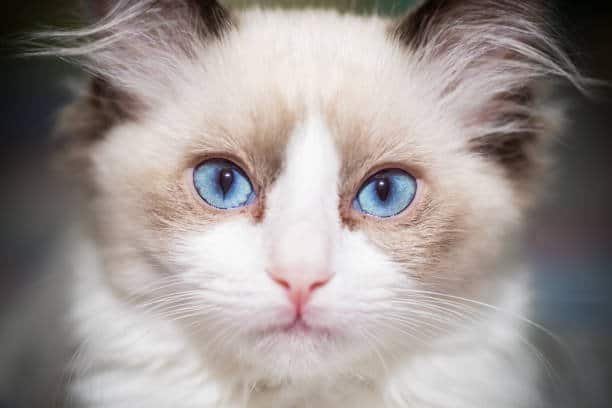
Exploring the Various Colors of Lynx Ragdoll Cats
Lynx Ragdoll Cats come in stunning body color variations. They are Seal Lynx Point, Blue Lynx Point, Chocolate Lynx Point, Lilac Lynx Point, Cream Lynx Point, and Flame Lynx Point.
Seal Lynx Point Ragdolls
The Seal Lynx Point Ragdoll is a glamorous color variation of this affectionate cat breed. It gets its name from the deep seal brown color of the “points” – the face, ears, legs and tail. The body is a pale cream or white.
As the name suggests, Seal Lynx Points also feature tabby style stripes on the face, legs and tail. These stripes combined with the sharp contrast between the dark points and light body give Seal Lynx Points a wild, exotic look.
The seal brown color is the original and most common Ragdoll point color. It is caused by a gene called b, which results in a rich, warm chocolate brown. The lynx-style striping likely comes from a form of partial albinism that limits color to just the tips of the fur shafts.
Seal Mitted Lynx Ragdoll
The Seal Mitted Lynx Ragdoll combines three distinctive coat patterns – the seal brown points, tabby lynx striping, and white mitted paws. These cats have the trademark seal brown color on the face, ears, legs and tail.
Striking tiger-like bands accent the legs and cheeks. White mittens adorn the front paws. The body is a pale cream or white.
Blue Lynx Point Ragdoll
Blue Lynx Point Ragdolls are a beautiful breed of cats with bluish-grey coat types. They have darker shades of blue-grey on their fur, creating a unique Lynx pattern. These cats also have the iconic “M” marking on their foreheads and other tabby patterns on their face, legs, and tails.
Chocolate Lynx Point Ragdolls
Chocolate Lynx Point Ragdolls are a specific color variation of this lovely cat breed. They come in shades of light brown, medium brown, and dark brown color. The exact color can be influenced by genetics, diet, and location.
These cats have beautiful lynx patterns on their fur, characterized by tabby-like stripes. Show-quality Chocolate Lynx Point Ragdolls should have these distinctive markings and a rich chocolate color.
Blue lynx bicolor ragdolls
The Blue Lynx Bicolor Ragdoll is a variation of the Lynx Point Ragdoll breed with a unique color pattern. It has the signature blue-gray “points” (face, ears, legs, tail) of a Blue Lynx Ragdoll. But it also has additional white spotting/markings on the body, as indicated by the “Bicolor” name.
The bicolor pattern is created by the white spotting gene, which produces random patches of white on the body.
Common white markings include a white inverted “V” on the face, white chest, white belly, and white paws. The white areas contrast dramatically with the blue-gray points and pale cream body. No two bicolor patterns are exactly alike.
Lilac Lynx Point Ragdoll
Lilac Lynx Point Ragdolls are a unique color variation within the Ragdoll breed. They have a base coat ranging from cream to fawn, with complementary Lynx patterns in different lilac shades.
These beautiful Lynx cats also have striking blue eyes, a common and desirable feature among Ragdolls. Due to their rarity, Lilac Lynx Point Ragdolls are highly sought after by cat enthusiasts.
Cream Lynx Point Ragdoll
The Cream Lynx Point Ragdoll cat is a stunning vision with its soft creamy facial points and legs contrasting elegantly against a pale white body. A dilution gene washes out the typical seal brown or gray points into a warmer beige tone.
Cream Lynx Points also inherit the signature tabby striping in the face, legs and tail that gives Lynx Points their exotic flair. Personality-wise, the Cream Lynx Point is a classic mellow, affectionate Ragdoll. They form deep bonds with their families and eagerly snuggle into welcoming laps.
Flame Lynx Point Ragdoll
Flame Lynx point Ragdolls are another among the various Ragdoll cat breeds. These beautiful cats originated in Riverside, California, in the 1960s. The Lynx pattern in their coat comes from crosses between purebred Ragdolls and the classic tabby gene.
Flame Lynx point Ragdolls have alternating lighter color bands and dark coloration bands on each hair shaft. It creates eye-catching patterns on their luxurious fur. They have a regal appearance, medium to long coats, and a striped pattern.
Like other Lynx Ragdolls, Flame Lynx point cats are gentle and affectionate. They often follow their owners around, seeking companionship and attention.
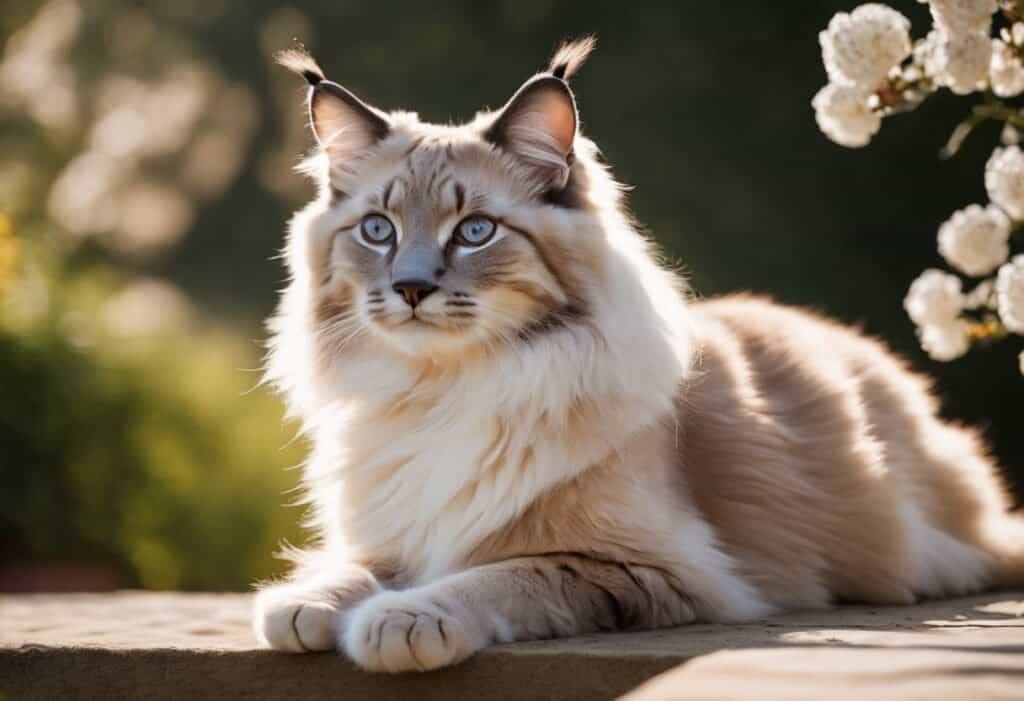
Temperament and Personality of Lynx Ragdoll Cats
These cats are described as “puppy-like” because they desire companionship and attention. One of the key characteristics of Ragdoll cats is their famously docile, people-oriented personality. And the Lynx Point Ragdoll is no exception. Here’s what to expect from these mellow, loving cats:
Laidback and Sweet-Natured
Like all Ragdolls, Lynx Points tend to be extremely relaxed, sweet and gentle cats. They love being around people and bond strongly with their families. Rarely aggressive, these cats often go limp when picked up, earning the “ragdoll” name.
Affectionate Lap Cats
The ideal place for a Lynx Point Ragdoll is right next to their beloved humans. They thrive on petting, rubbing and just hanging out in your lap. In fact, they’ll often follow you from room to room to keep you company.
Gets Along with Other Pets
With their calm, friendly nature, Lynx Point Ragdolls generally coexist well with cat-friendly dogs, other cats, and even kids. Proper introductions are still important, but they rarely have aggressive tendencies.
Highly Intelligent and Trainable
These cats are smart and insightful, quickly learning routines, commands and tricks. Their people-focused personality makes them highly motivated to please their owners. Many play fetch and walk on leashes.
Quiet Voices
Lynx Points use their voices sparingly, with most choosing to purr and “chirp” rather than meow loudly. They’ll still communicate their needs, just in a quiet, unobtrusive way.
How do you care for and groom your Blue Lynx Ragdoll Cat?
Caring for your Lynx Ragdollfurry companion ensures optimum health traits and happiness. Here are some tips for grooming schedule and caring for your furry friend:
- Brush their luxurious coat regularly with a soft-bristle brush to prevent matting and remove loose fur. Try the Aumuca cat brush for shedding issues or the Hertzko slicker brush for an appropriate grooming schedule.
- Trim their nails every few weeks using a cat nail trimmer or clippers. Prevent nails from becoming too long or sharp. Popular nail trimmers include Pet Republique Trimmer, Mr. Pen Clipper, Shiny Pet Clipper, etc.
- Clean their ears monthly with a gentle ear-cleaning solution and cotton balls to remove dirt and wax buildup. Petpost ear cleaner wipes, Vet’s Best Finger Wipes, Akoslale Cotton Swabs, etc., can be used.
- Provide regular dental care by brushing their teeth with a pet-safe toothbrush and toothpaste specifically designed for cats. H&H Pet’s Dental Kit, Petrodex Dental Care Kit, and Arm & Hammer Cat’s Kit are ideal recommendations. It protects their teeth from gum disease and provides optimal dental health.
- Schedule regular veterinary check-ups to monitor their health traits and vaccinations and detect potential issues early on.

Health and Lifespan
Lynx Ragdoll cats are prone to genetic diseases like hypertrophic cardiomyopathy (HCM) and polycystic kidney disease (PKD). These common health issues are important to monitor, so regular veterinary check-ups are necessary.
- Hypertrophic cardiomyopathy (HCM) is a genetic heart disease that causes the heart muscle to thicken. This can lead to problems with the heart’s ability to pump blood and, eventually, heart failure or sudden death. HCM is a common genetic heart disease in Ragdoll cats.
- Polycystic kidney disease (PKD) is when fluid-filled sacs (cysts) develop in the kidneys. This can damage the kidneys and lead to kidney failure. PKD is among the common genetic diseases in Ragdoll cats.
- Uroliths are stones that form in the urinary tract. Several factors, including dehydration, urinary tract infections, and genetics, can cause uroliths. Uroliths can be painful and can block the urinary tract, which can be life-threatening.
A healthy diet and exercise keep Lynx Ragdolls in good health. A healthy kitten can live up to 18 years and has an average lifespan of 12-15 years.
Lynx Point Ragdoll Cat Color Genetics
Ragdolls are said to possess the Himalayan gene. It is temperature-sensitive and can lead to pigmentation suppression in certain fur areas. If the temperature is warmer, the fur will be lighter shade.
The unique coloration of Lynx Point Ragdoll cats is the result of several interacting genes that produce their signature pointed pattern and vivid facial markings. Here’s a look at the key genetic factors behind this beguiling cat breed:
Pointed Gene
All Ragdolls carry two copies of the cs gene, which causes darker color at the cooler points (face, ears, legs, tail) and creamy white on the warmer body. This temperature-sensitive gene originated in Siamese cats.
Color Genes
Seal Lynx Points have the b gene for chocolate brown fur. Blue Lynx Points have a dilute gene that washes out the brown into grayish-blue. Red/cream Lynx Points involve modifiers of the orange o gene.
Tabby Genes
Many Lynx Points inherit the agouti striping gene, producing the signature horizontal stripes on the face, legs and tail. This tabby patterning adds drama to the points.
Albinism Genes
A partial albinism gene is thought to restrict pigment even further in Lynx Points, resulting in striped color just at the tips of the fur. This generates the eye-catching “lynx” look.

Where Can I Get Blue Lynx Ragdolls?
Finding a Lynx Ragdoll furry companion is easy if you are not looking for any specific color pattern or shade. You can do a kitten search at both reputable breeders and adoption centers.
Professional breeders take pride in their litter due to the maintenance of breeding standards and enhanced pet quality. They perform several genetic tests and ensure optimal conditions before breeding two cat parent breeds. Their cats come with a health guarantee.
Besides, animal shelters or adoption centers can be great options if you want a budget-friendly option. Adopting from a rescue prevents pet overpopulation and provides a loving home to needy cats.
| Breeders | Adoptions |
| American Ragdolls | Adopt-a-Pet |
| KFBear Ragdolls | Petfinder |
| My Champion Heart Ragdolls | GoKitty |
Does A Blue Lynx Ragdoll Make A Good Pet?
The blue lynx Ragdoll can make an excellent pet for many families due to its combination of affectionate personality traits and striking coat pattern:
Temperament
- Docile, relaxed – Ragdolls are known as a docile, calm breed that bonds strongly with their families. They tend to be very affectionate and enjoy receiving attention.
- Playful, kittenish – Ragdolls maintain a playful, curious spirit throughout adulthood. Many enjoy interactive play with toys and tend to learn tricks readily.
- Good with other pets – Ragdolls generally coexist well with cat-friendly dogs, and other cats, and calm children when properly introduced.
- Adaptable – They tend to adjust well to new environments and moderate activity levels in a home. Loud noise does not bother them.
Physical Traits
- Large size – A mature blue lynx Ragdoll can weigh 15-20 lbs. Their substantial size appeals to many families.
- Stunning coat – The pale, silvery blue mask, ears, legs and tail contrast beautifully against the plush, cream-colored body fur.
- Low shedding – The dense, soft coat of a Ragdoll sheds minimally compared to many breeds, making grooming easier.
Frequently Asked Questions
What are the earliest records of the blue lynx ragdoll?
This Ragdoll breed originated from a longhaired cat named Josephine, who Ann Baker owned in the 1960s. Josephine, a white Angora-type cat, had a litter of kittens with unique qualities.
What makes a Ragdoll lynx?
A Ragdoll is considered a lynx point when it has the distinctive pattern of darker coloring on the ears, face, legs, tail and paws that contrasts with a lighter body. This signature lynx pattern is one of the original pointed patterns that help identify a cat as a Ragdoll breed.
How much do lynx point Ragdolls cost?
Prices for lynx point Ragdoll kittens generally range from $1000 to $1500. The specific price can vary based on factors like pedigree, breeder reputation, availability and location. Some breeders may charge more for kittens with blue eyes or other desired traits. Overall lynx point Ragdolls tend to be on the higher end of prices for Ragdolls.
Do Ragdolls have lynx tips?
Yes, Ragdolls with the lynx point pattern will have noticeably darker tips on the ears, face, legs, tail and feet. This contrasts with the lighter main body color. The sharp demarcation between the darker points and lighter body is a signature mark of a lynx point Ragdoll.
What is a Lynx point Ragdoll cat?
A lynx point Ragdoll is a Ragdoll cat that has the distinctive lynx point pattern of darker extremities contrasting with a lighter body. The cat’s ears, face, legs, tail and paws will be markedly darker than the main body color. Common lynx point colors are seal, chocolate, flame and blue.
What is the lifespan of a lynx point Ragdoll?
The average lifespan of a lynx point Ragdoll is between 15-20 years. This is on par with the typical lifespan of the Ragdoll breed in general. Proper care and indoor lifestyle can help a lynx point Ragdoll reach the longer end of the lifespan range.
Are lynx ragdolls rare?
No, lynx ragdolls are not considered rare. Lynx is one of the four original point patterns in Ragdoll cats, along with bicolor, mitted and solid. Lynx point Ragdolls remain very popular and common within the breed.
What is a ragdoll lynx kitten?
A ragdoll lynx kitten is a young Ragdoll cat that exhibits the lynx point pattern of darker extremities contrasting with a lighter body. These kittens will have noticeably darker ears, face, legs, tail and paws compared to the body, even as young kittens. Common colors for lynx kittens include blue, seal and chocolate points.
What is a seal lynx ragdoll?
A seal lynx Ragdoll has a light fawn to cream colored body with seal brown points on the ears, face, legs, tail and feet. The seal brown points are slightly darker than blue lynx points. The paws are very dark seal brown. The nose, lips and paw pads are brownish-black.
What is a blue lynx ragdoll?
A blue lynx Ragdoll has a light beige body with slate blue-gray points. The points on the ears, mask, legs and tail will be a distinctive grayish blue. The paws are a darker blue-gray. The nose leather, lips, and pads are also blue-gray in color.
Are lynx ragdolls purebred?
Yes, lynx ragdolls are considered purebred Ragdoll cats. The lynx colorpoint pattern is one of the original patterns in Ragdoll breeding history and is accepted by cat registries as a purebred Ragdoll trait. To be purebred, a lynx ragdoll must also trace its pedigree back to foundation breeding Ragdolls.


